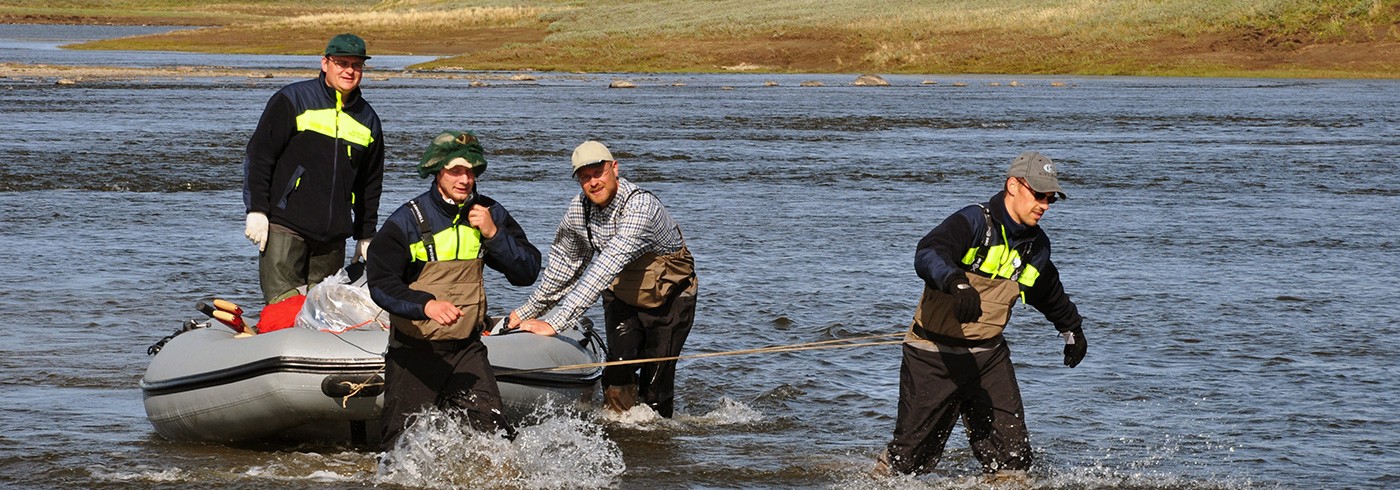
Dolgan tents ledge loaded on one of our zodiacs for crossing the Bolshaya Balaknya River. Photo: Per Möller

The gang and the Dolgans. Photo: Per Möller

Base camp 7 at midnight. Photo: Per Möller

Cutting up a leg of reindeer. The inner part of the loin was superbly tender and tasted fantastic as medium rare steaks with a lot of fried onion! Photo: Per Möller

Mussels and snails from our last digging site, supposedly from the last interglacial, the Eemian, some 130–115 thousands years ago. Photo: Per Möller

Falcon chick after crash-landing.

The Mi8 helicopter in for landing for our pickup. Photo: Per Möller
Last week the summer came back to us. We finished off the remaining geologic work in the sections around base camp 6 last Monday and set off for base camp 7 on Tuesday, of course in the usual rain. We had only travelled 16 kilometres when we saw the whole Dolgan family group at the left bank of the river, their sledges lined up as they knew we were coming for their help. As the river is unusually deep for this time of the year – lucky for us – they have had troubles to find a sufficient shallow stretch for pulling the sledges over to the other side, and had previously asked for our help. But how could they know we were passing just this day, and seeming ready for us? Well, their large tent sledges took two crossings, and then the rest of their 12 sledges could be taken two and two on one of our unloaded zodiacs together with kids and dogs. But it took us 2.5 hours. As a thank you for this they handed over a whole large back leg of a reindeer – a lot of fresh meat again!
The dark sky broke up during the afternoon, and as we reached base camp 7 after some 60 kilometres, there was a brilliant blue sky and the landscape bathed in the golden sunshine as the sun now stands very low at night. The week before it eventually dropped below the horizon for an hour before rising again. To our disappointment we found no interesting geologic sections along the passed river banks, as also was the case further downstream and also along a secondary stream flowing into the Bolshaya at the camp. So, the thought was that the geologic work was over for this expedition. Well, laying in the dry grass, resting and reading in the beautiful sunny weather was not that bad.
However, Ivar and Love got restless the second sunny day and decided to scout a channel of the Bolshaya a little bit upstream, used only during the spring high waters. They came back with an astonishing mollusc and gastropod fauna collected on the beach below some clay sections, a fauna of a kind we previously had not encountered, indicating marine conditions during an interglacial with much warmer water than at present in the area. So, field boots on again, and during last Friday we had a hard day of digging and sampling these sediment. As always, falcons and geologists prefer the same sites, high and steep bluffs.
So, of course we had a falcons’ nest right above us in our preferred digging spot. The chicks were, however, quite grown up, the four of them sitting on line watching us. One of them had just started to try its wings, but not with great success. Suddenly I heard a “bump” in the grass behind me, and there he was lying in crash-landing position. When I reached out my hand he went into defence position on his back with claws stretched out and hissing at me. But when I took him up in my hands he settled quickly at ease after some caressing. Put back on top of the bluff he took off with some greater success to the former nest.
As some of us did this work, others started to sort up expedition gear and geologic samples, completing sample tables, and to disassemble two of our zodiacs as preparation for the coming Mi8 helicopter pick up on Sunday the 15th for transport to Khatanga. No problem with flying weather, the sky was brilliant blue but with a cool strong wind from the east. The helicopter came in at noon and flew us along the Bolshaya Balaknya River to its delta in Khatanga Bay – our intended but cancelled route with the zodiacs – and then along Khatanga River to Khatanga, ca. 300 km. For the last 100 km we flew in the boarder-zone between the tundra and the with larch-trees sparsely clad taiga. Grasses and scrubs had started to take on autumn colours, displaying an array of green, yellow, golden and deeply red colours. Grounded in Khatanga after the flight it was like a heat wave that struck us; it was Indian summer temperatures at 22 °C. After unloading all stuff and brought to a temporary storage room for later sorting and packing, a cold beer tasted just awesome.
Per Möller, Department of Geology, Lund University







